
Quang Binh Province is situated in the north central region and shares borders with Ha Tinh Province to the north, Quang Tri Province to the south, Laos to the west and the East Sea to the east. The capital city of Quang Binh is Dong Hoi, which is approximately 500 km away from Hanoi and around 1,000 km from Ho Chi Minh City.
Quang Binh experiences two distinct seasons: the rainy season from September to March, and the dry season from April to August. From November to March, temperatures in Quang Binh are cooler, ranging between 17-22 degrees Celsius. The ideal time to visit is from late March to early September.
During the rainy season, there may be limitations on transportation and activities such as swimming and caving. However, for those who enjoy exploration, Quang Binh still offers its own charms in the wet season. From August to November, you can wade in rivers and streams or engage in activities like kayaking and stand-up paddleboarding in Minh Hoa District.
Quang Binh experiences harsh weather conditions, with hot summers and rainy seasons towards the end of the year. It is crucial to choose the appropriate time to visit and make thorough preparations, especially when traveling with young children or elderly individuals.
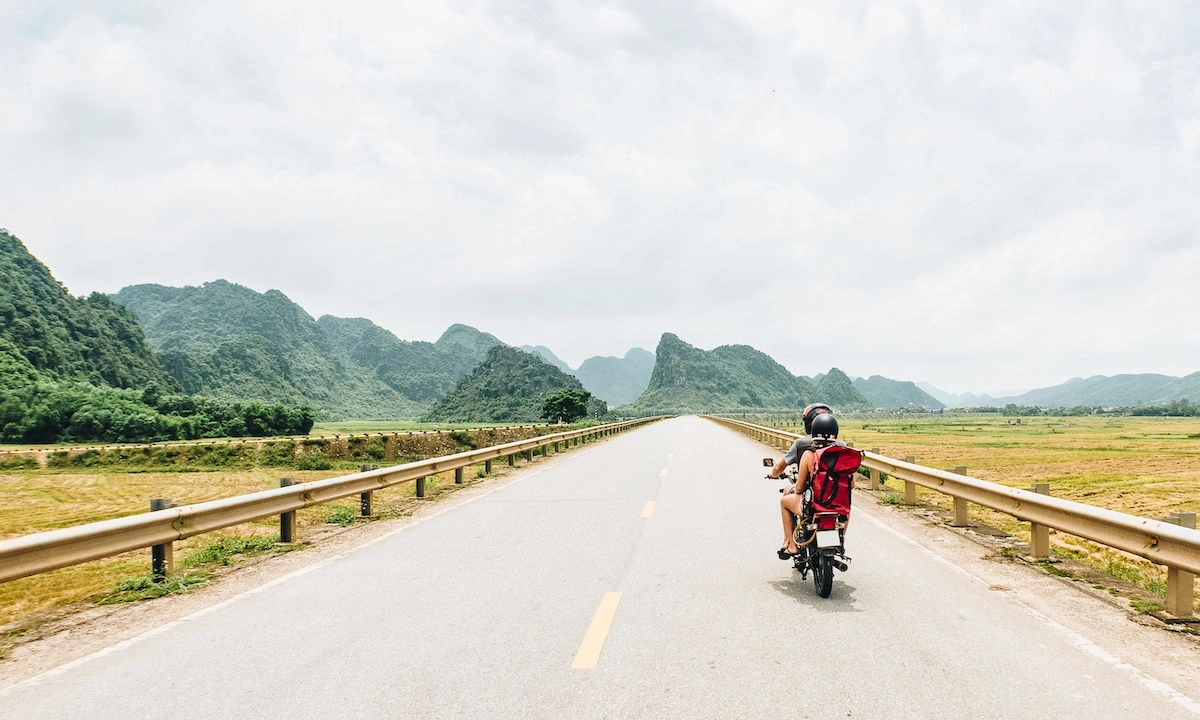
Phong Nha - Ke Bang National Park
Phong Nha - Ke Bang National Park was recognized as a World Natural Heritage site by UNESCO in 2003. It has over 400 caves, spanning a total length of 220 kilometers. The park is home to three major rivers: Chay River, Son River, and Trooc River. Situated approximately 50 kilometers away from Dong Hoi City, it encompasses the districts of Bo Trach and Minh Hoa.
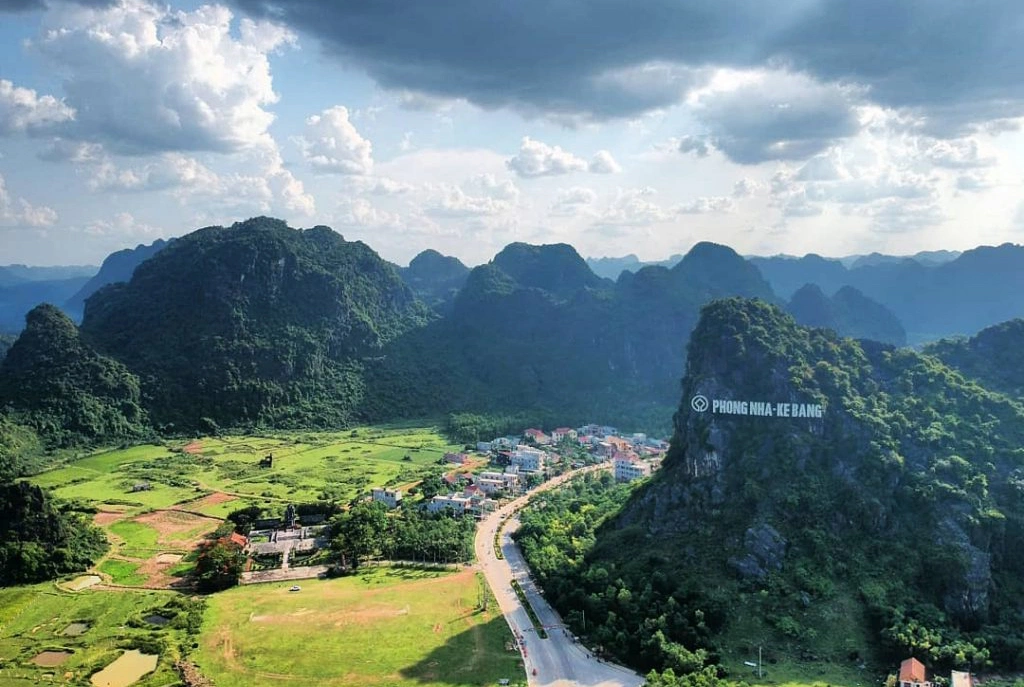
The botanical garden serves as an educational hub where visitors can learn about endemic plant and animal species. It showcases and preserves samples of endangered, rare, and prioritized species in Vietnam. A short walk around the garden allows visitors to visit Gio Waterfall and wildlife care areas.
Cave system
Quang Binh is renowned for its kingdom of caves, boasting numerous untouched caves, many of which have secured world records.
Phong Nha Cave
Phong Nha Cave originated hundreds of millions of years ago through the process of weathering in limestone mountains.
This giant cave features an exquisite underground river, a spacious and wide entrance, stunning sandy beaches and reefs, a beautiful underground lake, a large and magnificent dry cave, a system of enchanting stalactites, and an extremely long water cave system.
To explore Phong Nha Cave, visitors start at the Phong Nha Tourist Center and embark on a 30-minute journey up the Son River.
Paradise Cave
A veritable underground palace, Paradise Cave is located approximately 70 kilometers northwest of Dong Hoi City, adjacent to the western branch of the Ho Chi Minh Road and roughly 25 kilometers away from Phong Nha Cave.
Visitors must ascend over 500 steps to reach the cave. Once there, they encounter a vast space adorned with countless stalactites and stalagmites. With a length of 31.4 kilometers, Paradise Cave claims the title of the longest dry cave in Asia.
Son Doong Cave
Son Doong Cave presently holds the title as the largest natural cave in the world. It formed around 2-5 million years ago and boasts dimensions of approximately 150 meters in width, over 200 meters in height, and nearly 9 kilometers in length. The estimated volume of Son Doong Cave is a staggering 38.5 million cubic meters, with stalactite columns reaching heights of 14 meters. The cave is also home to a 2.5 kilometer-long underground river, coral populations, and fossilized animal remains. Additionally, Son Doong features two sinkholes that allow sunlight to penetrate, enabling the growth of the tropical forest-like area known as the "Garden of Edam."
To visit Son Doong, visitors must purchase a tour, prepare physically, and familiarize themselves with safety regulations. Tours operate from the end of January to August each year, with a duration of 5 days and 4 nights. The average tour group consists of 10 people, and the current price per person is VND72 million (US$3,061.16).
Tu Lan Cave
The Tu Lan cave system resides within the limestone mountains of a primeval forest. It spans an area of over 650 hectares in Tan Hoa Commune, Minh Hoa District. The British Vietnam Caving Expedition Team initially explored the Tu Lan cave system in 1992. As of 2022, experts have discovered, surveyed, and measured more than 25 large and small caves.
Tu Lan encompasses a system formed along the Rao Nan River, located outside the boundaries of Phong Nha - Ke Bang National Park. The caves within the Tu Lan system include both wet caves, with streams inside, and dry caves. Notable caves include Chuot, Hung Ton, Bi Mat, Song, Ken, Kim, and Tien caves. Dry caves are often home to unique stalactites because they are not affected by the rainy season. Visitors can swim within the underground cave system and camp in the forest.
En Cave
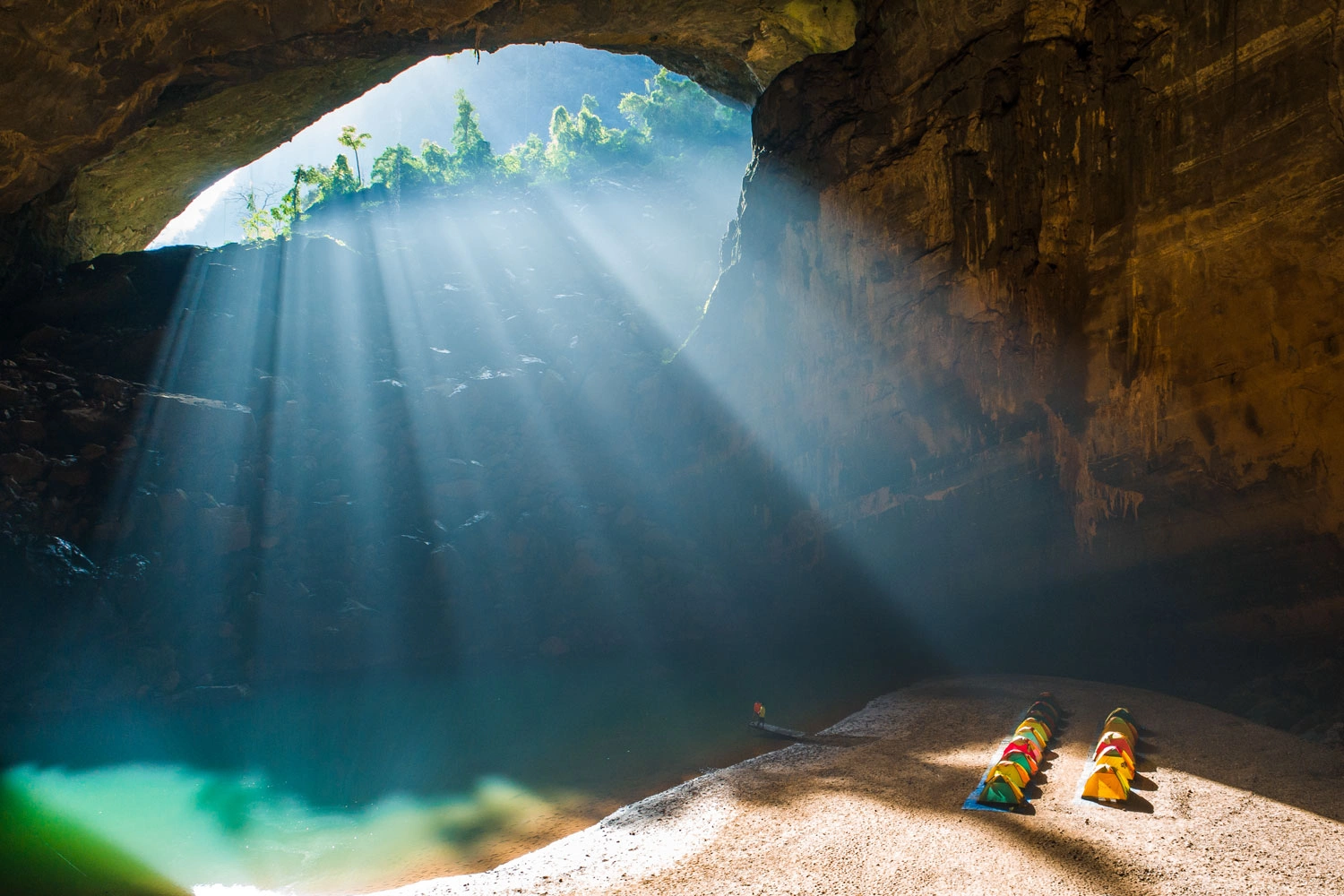
Visitors can set up camp along the journey in En Cave. Photo courtesy of Oxalis Adventure
En Cave, the third-largest cave in the world, stretches for 1.6 kilometers through a massive limestone formation. It features three entrances, with the largest and most famous entrance measuring 120 meters in height and 110 meters in width. The ceiling reaches a towering height of 145 meters, while the widest corridor spans 200 meters. The cave houses a stream that leads to Son Doong Cave, and it served as a filming location for scenes in the Hollywood movie "Peter Pan."
Tours to explore En Cave are available from December until the end of September each year. The journey to En Cave extends over two days, involving activities such as trekking through forests, crossing streams, ascending slopes, and exploring Ban Doong Village, home to the Bru-Van Kieu community.
Pygmy Cave
Pygmy Cave, the world's fourth-largest cave, resides deep within Phong Nha - Ke Bang National Park. Discovered in 1997, its entrance stands 100 meters high and stretches over 845 meters long. During daylight hours, the cave is permeated by natural light, while its exit serves as a campsite.
Within Pygmy Cave, water flows from the ceiling, providing drinking, cooking, and living sustenance. The cave's depths are infused with ample light, fostering lush green fern growth. At the exit, visitors can witness locals' forest and bamboo rope setups, utilized for harvesting bird's nests and honey.
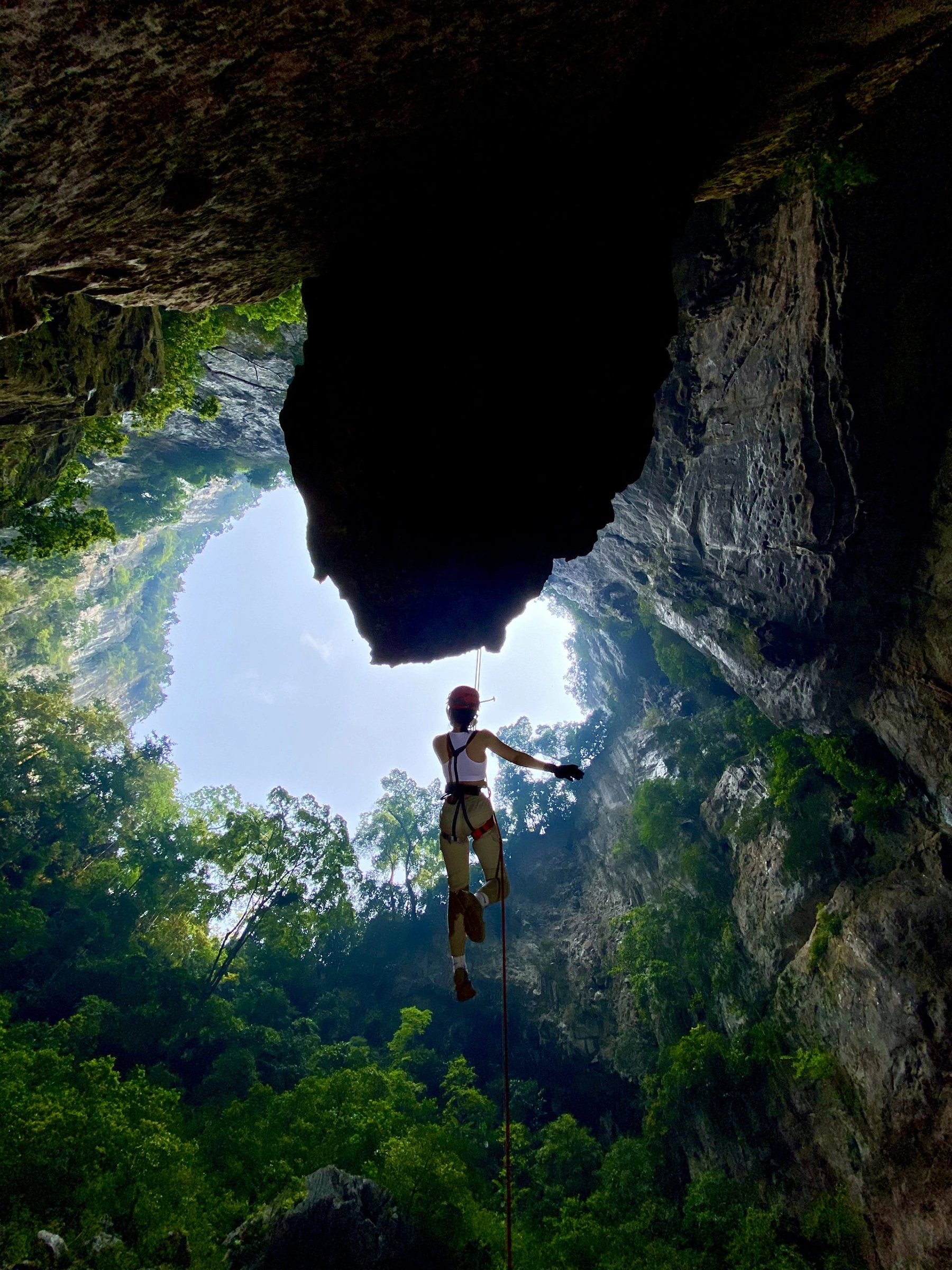
Kong Collapse
Kong Collapse, part of the Tiger Cave system within the Phong Nha - Ke Bang area, showcases a resemblance to the giant monkey head featured in the movie "Kong: Skull Island," which was filmed in Quang Binh. With a depth of 450 meters from mouth to bottom, it stands as one of the world's deepest sinkholes.
Exploring Kong Collapse represents the most challenging adventure tour available in Vietnam today, involving a 100-meter swing, a 23-kilometer hike, a 300-meter swim, and a 7-kilometer cave exploration. The journey entails traversing small trails with continuous ups and downs, passing through Pygmy Cave, and camping in Over Cave.
System of rivers and lakes
Gianh River
Considered a symbol of Quang Binh province, the Gianh River stretches for 160 kilometers. It originates from the 2,017-meter-high Co Pi Mountain on the edge of the Annamite Mountain Range. Flowing through the districts of Minh Hoa, Tuyen Hoa, Quang Trach, and Bo Trach, it eventually empties into the sea. Alongside the Gianh River, Quang Binh boasts four other major river systems: Roon, Ly Hoa, Dinh, and Nhat Le rivers.
Son River
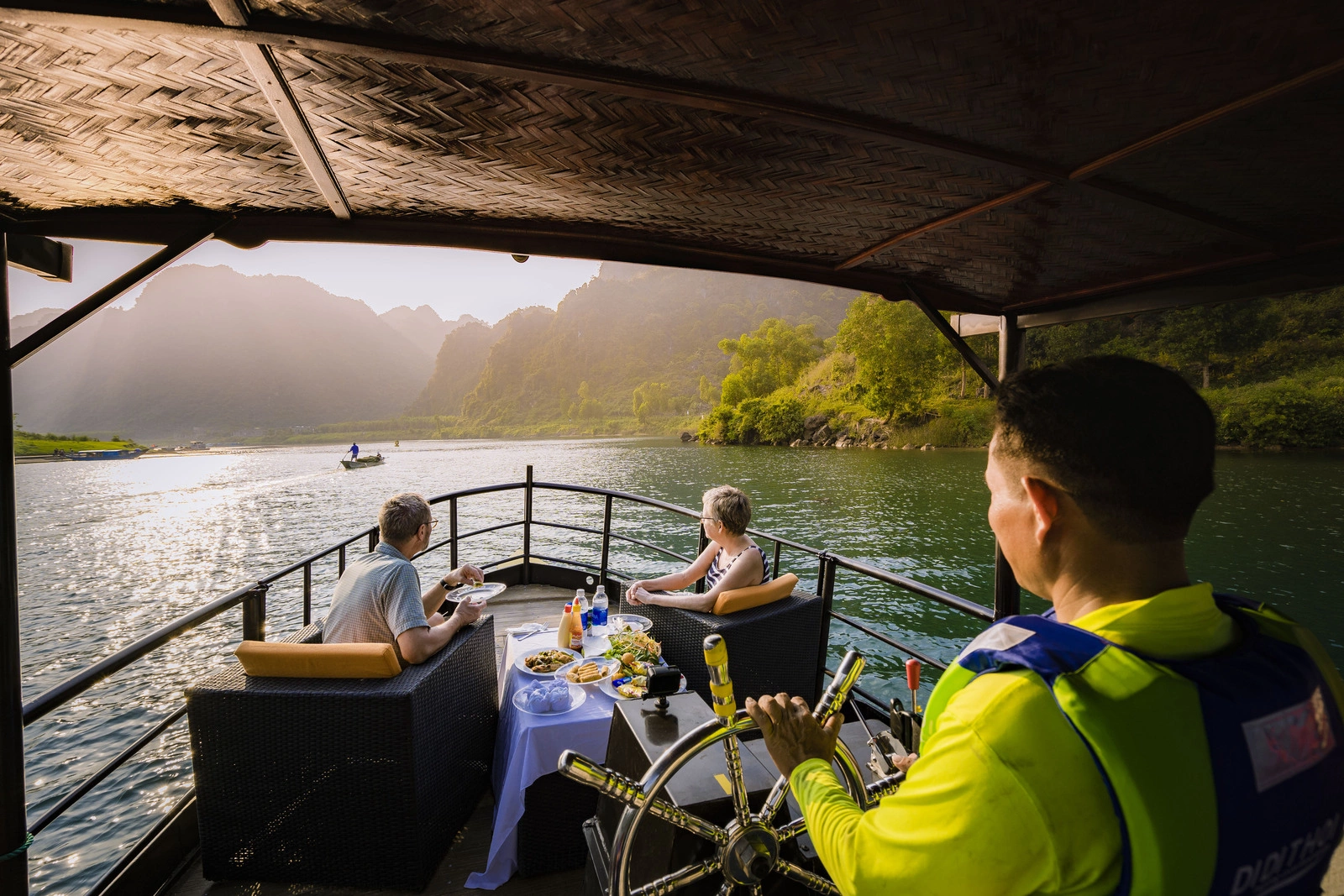
A dinnertime boat ride on the Son River. Photo courtesy of Oxalis
Also known as Nguon Son, Rao Son, or Trooc River, the Son River flows entirely within Quang Binh province. Its upstream section extends over 7,700 meters, flowing underground through the limestone mountains west of Quang Binh. The Son River emerges from the mouth of Phong Nha Cave and meets the Gianh River in Ba Don Town. Daytime boat tours are available on the Son River and Gianh River, offering visitors a chance to enjoy rustic villages, majestic mountains, and lush forests.
Nhat Le River
Also originating in the Annamite Range, the Nhat Le River meanders into the East Sea through the Nhat Le Estuary. The name "Nhat Le" translates to "bright sun," and witnessing the sunrise along the river is a popular experience with both locals and visitors. At sunrise, the golden sun appears to be embedded in the water when viewed from the south bank of the river, with the Bao Ninh sand dunes in the background.
Nhat Le Beach
Once recognized as one of the ten most appealing coastal tourist destinations in Vietnam by the Vietnam National Administration of Tourism, Nhat Le Beach is approximately 2 kilometers from the Dong Hoi city center. Its features include white sand, clear blue water, and gentle waves lapping on the shore.
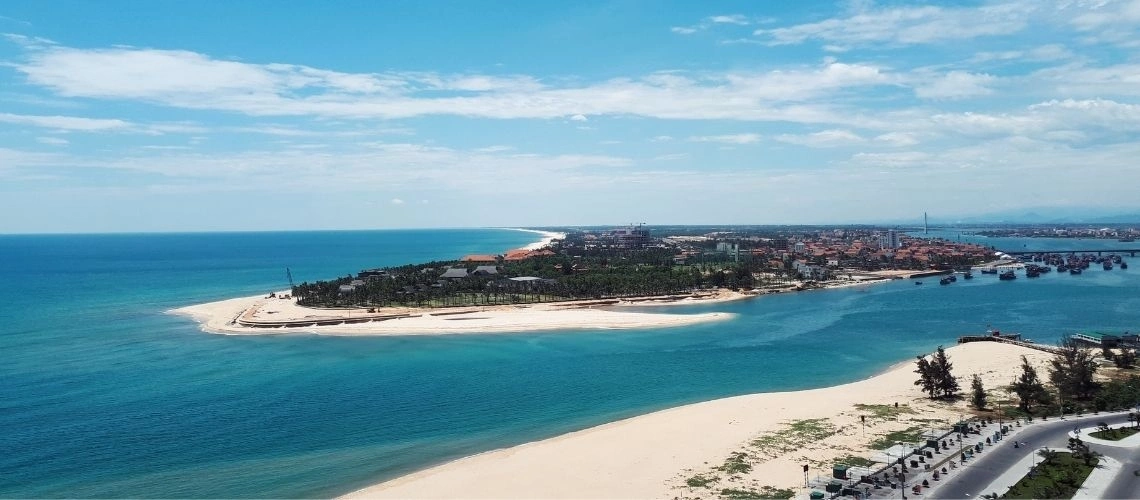
Bao Ninh Peninsula
Situated on the eastern side of Dong Hoi City, Bao Ninh Peninsula is bordered by the sea on one side and the Nhat Le River on the other. In addition to swimming and sightseeing, visitors can engage in various sports activities such as volleyball, football, kite flying, surfing, and parachuting on the beach. The peninsula boasts a pristine coastline and also features historical relics such as ancient ramparts, the Ca Ong Temple symbolizing fisherman culture, the Truong Sa Citadel, Sa Chuy Fort, and the Mother Suot Monument.
Bai Da Nhay (Jumping Rock Beach)
Located in Bo Trach district, Bai Da Nhay is a picturesque spot situated approximately 26 kilometers north of Dong Hoi City along National Highway 1A. The coastal rocks have weathered over time. They’ve been shaped by the sea into natural animal-like statues, including a rooster, hen, elephant, and tiger, seemingly jumping amidst the waves. Visitors can partake in active recreational activities such as boating, climbing, or simply enjoying a leisurely stroll.
Coc Well, found at Bai Da Nhay, has crystal-clear water. The well's temperature remains warm in winter and cool in summer, often used by fishermen for worship at the Nam Hai Dai Vuong Temple, dedicated to a Tran Dynasty general.
Dong Hoi City
Quang Binh Quan
Dong Hoi City is home to Quang Binh Quan, a stronghold of the Luy Thay imperial system. Constructed in 1639, it served to aid Lord Nguyen of Cochinchina in resisting attacks from Lord Trinh of Tonkin. Quang Binh Quan was destroyed by the French army during their withdrawal from Dong Hoi in 1954. But it was subsequently rebuilt to resemble its original form over three centuries ago. In 1965, the site was once again devastated by American airstrikes. Today, Quang Binh Quan stands restored, showcasing its cultural and historical heritage.
Bell Tower of Tam Toa Church
Located in the heart of Dong Hoi City, by the Nhat Le River, Tam Toa Church boasts a bell tower standing approximately 10 meters high. Enduring numerous bomb attacks during the war, the church now retains only its front bell tower and a brick pillar on a stone foundation at the rear, yet it still exudes its ancient charm. This site holds significant cultural and historical importance within the province.
Dong Hoi Ancient Citadel
Dong Hoi Ancient Citadel is situated within the historical relics of Dong Hoi, dating back to the Trinh-Nguyen dynasties. It was constructed on the key land of the trans-Vietnam road from North to South. Presently, the citadel covers a distance of approximately 1,100 meters, featuring 15 zigzag sections. While the southern city remains largely intact, the eastern city boasts three gates. Despite enduring damage from two wars, the citadel has managed to preserve its original elements.
The Mother Suot Monument
The Mother Suot Monument, standing at 7 meters tall on the Nhat Le River banks, pays tribute to Nguyen Thi Suot, a heroic figure born in 1906 in Bao Ninh Town, Quang Binh Province. During the years of the resistance war against the U.S., she bravely assisted soldiers by ferrying them across the river and transporting ammunition between Dong Hoi and Bao Ninh.
Ngang Pass
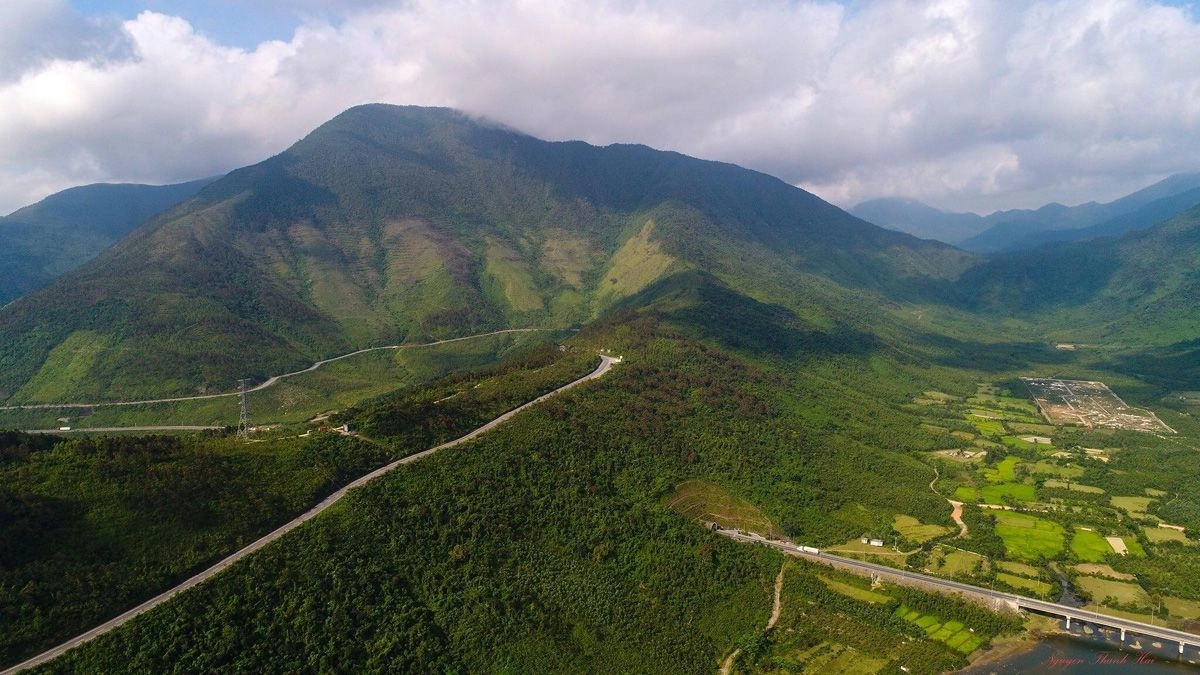
Located between Ha Tinh and Quang Binh provinces, Ngang Pass is a critical point on National Highway 1A, crossing the Hoanh Son mountain range. It spans 6 kilometers with a peak of approximately 250 meters. "Heaven’s Gate," a relic of the Hoanh Son Quan gate built in 1833, still stands at the pass. In 2004, the Ngang Pass tunnel was built, replacing the mountain pass.
Vung Chua - Yen Island
Situated in Tho Son Village, Quang Dong Commune, Quang Trach District, Vung Chua is a scenic spot located at the foot of Ngang Pass. It is about 4 kilometers south and over 2 kilometers east of National Highway 1A. Vung Chua offers a peaceful beach, complemented by Yen Island, creating a captivating view. This area is renowned as the resting place of General Vo Nguyen Giap, who is regarded as one of the greatest military strategists of the 20th century. This destination attracts thousands of visitors daily, especially during the Lunar New Year holidays.
Access to this area may be periodically closed, so it's advisable to contact in advance for information.
Chay River - Dark Cave
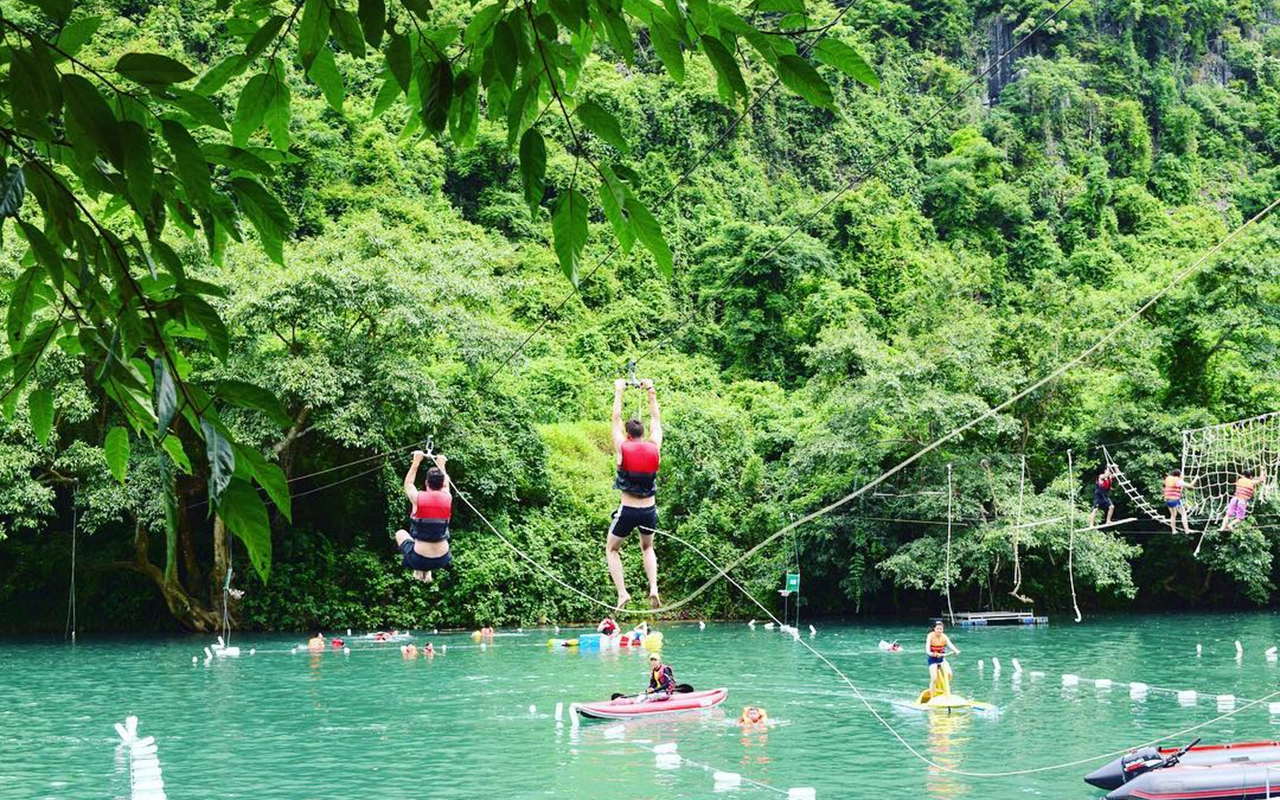
The Chay River, originating from a limestone massif, flows through villages and into Dark Cave, known for its ancient stalactite system. This natural formation represents the geological tectonic process of the Phong Nha - Ke Bang area. The Chay River - Dark Cave route offers opportunities for exploration, including activities such as ziplining, cave exploration, kayaking on the Chay River, swimming through Thuy Tien Lake in Dark Cave, and enjoying a mud bath for health benefits.
Mooc Spring
Situated in Bo Trach District, approximately 70 kilometers from Dong Hoi City, Mooc Spring Eco-Trail is located in the middle of a valley, surrounded by limestone mountains along the Chay River. The stream retains its blue color throughout the year, with even bluer hues on sunny summer days. Visitors can partake in various activities, including swimming, kayaking, fishing, and ziplining. Admission tickets and specific activity tickets are required for entry.
All-terrain vehicles (ATV) tour
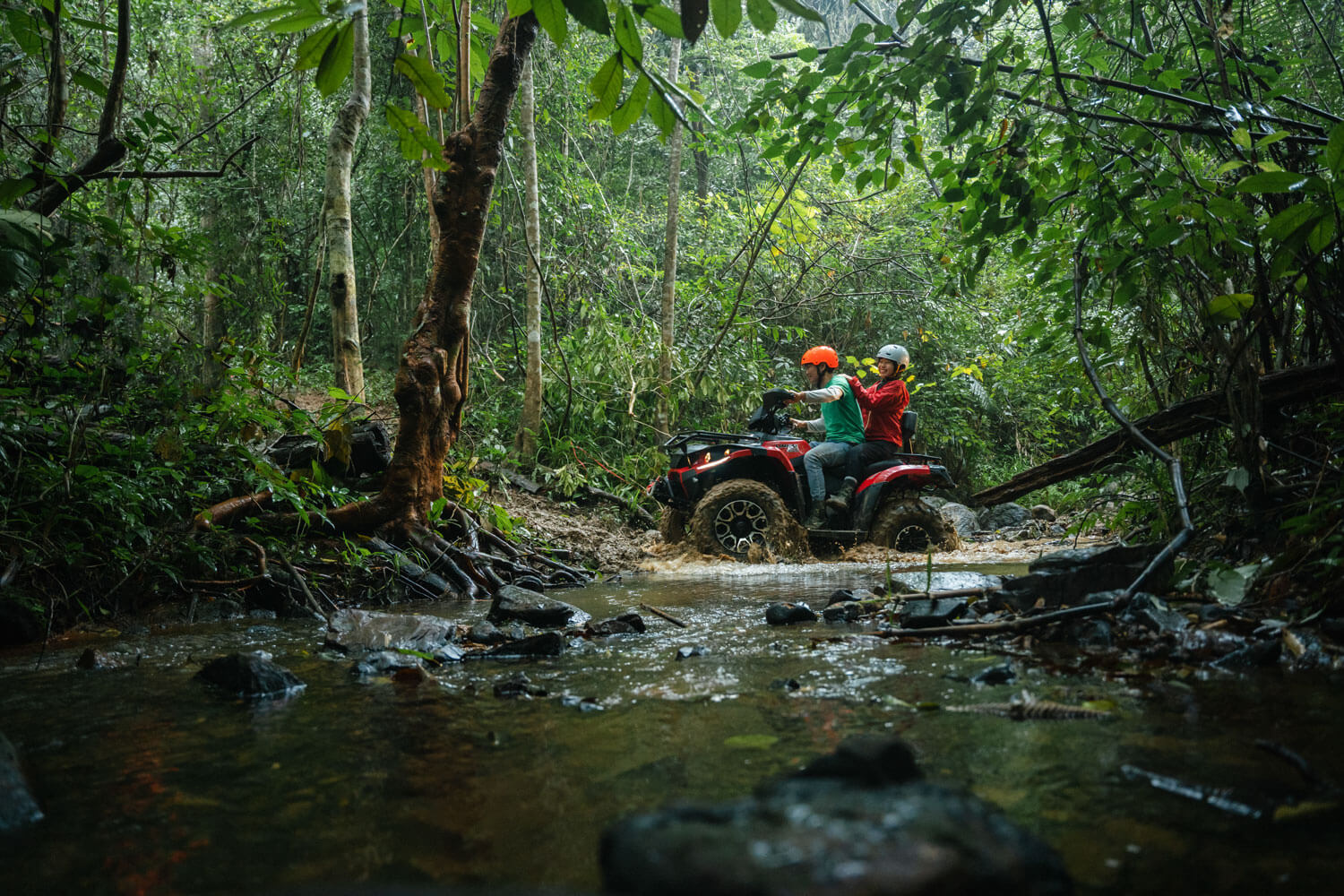
The tour "Explore Ironwood Forest - Home of Kong" offers an off-road driving experience in Tan Hoa Commune, Minh Hoa District. This area served as the filming location for the Hollywood blockbuster "Kong: Skull Island" in 2016. During the two-hour tour, visitors have the opportunity to drive through forests, conquer bends, slopes, streams, and even venture into dark tunnels.
Banh bot loc (shrimp and pork dumplings)
Banh bot loc is a delicacy one must not miss out on when visiting Dong Hoi. This treat features a shell made from tapioca starch, with fillings including shrimp and fatty meat, all wrapped in banana leaves. Once steamed, the crust becomes transparent, and the flavor becomes rich. Quang Binh's banh bot loc also includes green bean paste.
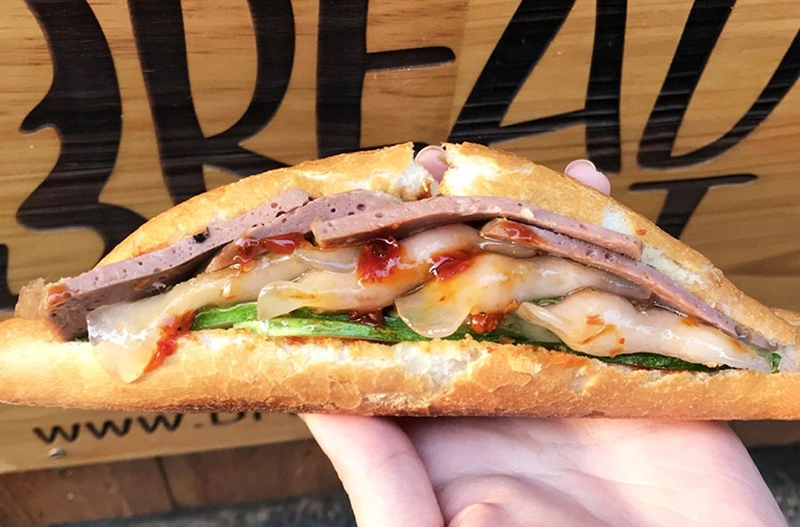
Banh mi bot loc (Baguette with shrimp and pork dumpling)
In Dong Hoi market or roadside stalls, you can find a breakfast delicacy known as banh mi bot loc. It consists of a hot baguette combined with about 7-8 shrimp and pork dumplings, topped with sauce and green onions. Each serving costs around VND10,000 - VND15,000 (43 cents - 64 cents).
Chao canh (thick noodle soup)
Chao canh, commonly found in Dong Hoi City and Ba Don Town, offers a flavorful broth with a touch of sweetness, soft noodles, and a hint of spiciness from chopped mustard greens. The dish is called chao canh because the broth has to be cooked to achieve the consistency of chao (porridge). In addition to Dong Hoi City, Ba Don Town is another place where you can find this dish. Ba Don soup is known for its rich flavors derived from sea fish like mackerel scad, herring, pomfret, and is served with spring rolls.
Bun cha ca thac lac (Fried fish cake noodle soup)
Bun cha ca thac lac is a dish consisting of fish cake made from clown knife fish, offering a balanced texture of softness and crispiness, and strong flavor. The broth, made from fish or pork bones, is sweet and fragrant. The noodle soup is often served with pickled purple onions, sliced chili, as well as lettuce and banana flowers. A bowl of this breakfast delight typically costs around VND30,000.
Chat chat
The residents along the Gianh River have a food known as chat chat. It features a type of mussel that is as small as a green pea. Quang Binh locals use these mussels to create a variety of dishes, including stir-fried chat chat served with sesame rice crackers, as well as incorporating them into noodle soup, porridge, or stir-fried dishes with unripe jackfruit.
Oyster porridge
This porridge is a dish from Quan Hau Town in Quang Ninh District, near the entrance of Dong Hoi City. It features fresh and delicious Nhat Le River oysters. The people of Quan Hau Town often serve this porridge to visitors when they visit the area.
Banh khoai (Crispy pancake)
Banh khoai is a must-try dish in Quang Binh. It’s similar to banh xeo but thicker and filled with beef and fresh shrimp. Diners can roll a piece of the pancake with rice paper, along with vegetables and dipped in sweet and sour fish sauce.
Seafood
Quang Binh offers a wide variety of seafood at reasonable prices. Popular preparations include bombay duck hotpot, fish salad, steamed crab, ram den (sea snake), and mam lep (fermented thryssa setirostris). Fish salad often features grouper or apricot fish dipped in lemon juice and rolled with different types of rice paper. Seafood restaurants in the center of Dong Hoi city and restaurants on boats along the Nhat Le River are known for serving fish salad.
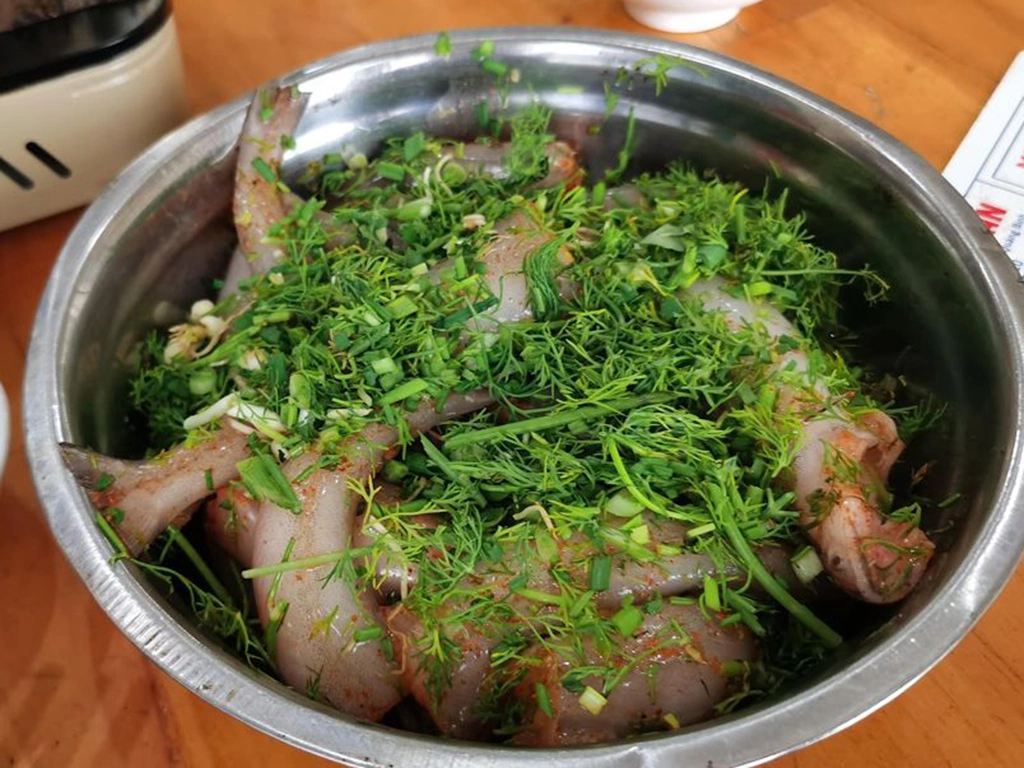
Bombay duck hotpot is topped with a generous amount of fragrant herbs. Photo courtesy of Phong Nha Explorer
Bombay duck hotpot
Bombay duck hotpot is specialty found in many restaurants in Dong Hoi City. This rustic hotpot combines tomatoes, star fruit, tamarind leaves, sour bamboo shoots, and pickled mustard greens, creating a delicious flavor that complements the soft and tender fish. Diners can also enjoy a variety of other seafood options.
Melaleuca mushrooms
Melaleuca mushrooms are a seasonal delicacy available only around April and August of the lunar calendar, lasting approximately 5-7 days after each rainfall. These mushrooms grow on melaleuca trees, have a bitter taste, and are used in stir-fries with sweet potato leaves, pork, shrimp, or in soups and porridge.
Chewy sweet potato
Chewy sweet potatoes are made from potatoes that have been harvested and left slightly dried. Once the potatoes lose their freshness and plumpness, they are washed, boiled, peeled, and thinly sliced. The slices are then exposed to the sun for 7 to 9 days, resulting in chewy sweet potatoes. These delicious sweet potato slices have a color resembling caramel, a flexible and sweet texture, and a distinct aroma of sweet potatoes.
Quang Binh offers a range of accommodation options, including hotels, motels, homestays, farmstays, and camping sites.
In Dong Hoi, you can choose to stay in the downtown area, such as Ly Thuong Kiet and Tran Hung Dao streets, or opt for hotels located near Nhat Le Beach on Truong Phap Street. Four to 5 star hotels in the city include Meliá Vinpearl Quang Binh, Muong Thanh Holiday, Muong Thanh Luxury Nhat Le, Sun Spa Resort, Celina Peninsula Resort, Gold Coast, and Saigon Quang Binh. Prices per night range from VND600,000 to VND2 million.
In districts like Le Thuy, Quang Trach, Bo Trach, and Minh Hoa, there are various accommodation options available at different price points.
Within the Phong Nha - Ke Bang National Park area (Bo Trach District), choose resorts that are close to nature, such as Chay Lap Farmstay, Nguyen Shack - Phong Nha Eco, Phong Nha Coco Riverside, Phong Nha Lake House, and Lucky Home. Prices per night for two people range from VND400,000 to VND2 million.
Blue Diamond Camp offers unique experiences, including exploring Son Doong Cave, which is the largest cave on Earth. The camp site features an underground swimming pool and a cooling system connected to the tent locations through insulated pipes. They also provide services like boating, cycling, and dining. Visitors can enjoy daytime activities or opt for overnight stays, with prices ranging from VND480,000 to VND1.1 million per person.
In Minh Hoa District, there are accommodation options suitable for both the dry and rainy seasons. Tu Lan Lodge costs around VND1.8 million per night. Additionally, there are spacious and comfortable homestays available, ranging from 26 to 40 meters square, suitable for 1-3 people, with prices starting from VND920,000 per night.
Dong Hoi city is approximately 500 kilometers from Hanoi and around 1,000 kilometers from Ho Chi Minh City. There are various convenient transportation options to reach Dong Hoi.
Direct flights are available from Hanoi and Ho Chi Minh City to Dong Hoi, with round-trip fares ranging from VND2 to 3 million ($85.03 to $127.55). Flights to Quang Binh are limited, with usually only two flights available per day. The flight duration is nearly 1 hour from Hanoi and nearly 2 hours from Ho Chi Minh City.
Dong Hoi Station is a stop for Thong Nhat, SE, and QB trains. One-way train fares range from VND450,000 to 1.4 million per person, depending on the class, seat, or bed.
Several bus operators serve the Quang Binh route, operating day and night buses. The Hanoi to Dong Hoi route is serviced by Hung Long, Hoang Linh, Phuong Trang, and Dong Hien with ticket prices ranging from VND300,000 to VND500,000 per person each way. The travel time is approximately 8-9 hours. From Ho Chi Minh City, you can choose Hoang Long, A Ba, or Loc Thuy bus companies, with fares ranging from VND400,000 to VND800,000 per person for a one-way trip. The journey takes about 20 hours.
If you prefer to drive your own car, you can take National Highway 1A or the Ho Chi Minh Road. Several sections now have highways, reducing travel time. The drive from Hanoi to Dong Hoi takes about 10 hours without traffic or extended breaks. Note that during public holidays, especially at the Hanoi entrance, there may be significant traffic congestion.
For scenic views, travelers can consider traveling along the Ho Chi Minh Road. Keep in mind that there may be intermittent loss of phone signal along this road, and adhere to speed limits and exercise caution when passing through residential areas. The travel time is 2-3 hours longer than using National Highway 1A, and there are no toll stations. The Ho Chi Minh Road takes you through the Annamite Range and famous national parks like Phong Nha - Ke Bang and Cuc Phuong.
Within Quang Binh Province, taxis are available for hire, and you can rent cars at locations such as Le Loi, Tran Hung Dao, and Huu Nghi in Dong Hoi City. Motorbikes can be rented at hotels for approximately VND100,000 - VND150,000 per day.
When participating in cave exploration and adventure tourism programs, it is essential for visitors to purchase tours from reputable companies and have knowledgeable guides who are familiar with the terrain to ensure safety.
The tourist and entertainment attractions in Quang Binh are primarily concentrated in the Dong Hoi - Phong Nha - Minh Hoa areas. To optimize time during short trips, it is advisable for visitors to select destinations within each specific area rather than undertaking long journeys of 60-70 kilometers.
Story by Tam Anh